#youtube ranking factors
Explore tagged Tumblr posts
Text
Here we mentioned the best factors for how to rank Youtube videos on google. There are many factors like keyword research, Video Engagement, youtube seo services, social media promotions, etc. Know more read here.
#Video SEO#YouTube Ranking Factors#Ranking YouTube Videos on Google#Enhancing Video Engagement#youtube seo services
1 note
·
View note
Video
youtube
Google Ranking Factors 2024 Rank On Google In 1 Hour Must See!
To learn more about "google ranking factors 2024" subject , please check out: ? https://videly-ranking.silversuccessnow.org/
This video is all about "google ranking factors 2024" subject information but we try to cover the following subjects: -how to rank google my business -how to rank #1 on google -rank on google in 1 hour
Take a deep breath and see the following vid about google ranking factors 2024 One thing I observed when I was searching for info on google ranking factors 2024 was the absence of appropriate information. Google ranking factors 2024 nevertheless is an subject that I know something about. This video therefore should be relevant and of interest to you.
Audio problems? If you see that the volume icon is disabled on YouTube videos, try the following troubleshooting actions:
Make sure that sound/volume is enabled on your browser or device. Reboot the web browser or device. wish to Embed this video? Under the vid , click SHARE button. Then Click Embed button. From popup that appears, copy the embed code. _________________________ Follow us Official Site: https://videly-ranking.silversuccessnow.org/ Twitter: Facebook: https://www.facebook.com/profile.php?id=61566453323174 Instagram:
Now that you have watched our video regarding google ranking factors 2024 did it helped? Please 'like' the YT vid to assist your friends looking for how to rank google my business or how to rank #1 on google :)
0 notes
Text
A Guide to Historically Accurate Regency-Era Names

I recently received a message from a historical romance writer asking if I knew any good resources for finding historically accurate Regency-era names for their characters.
Not knowing any off the top of my head, I dug around online a bit and found there really isn’t much out there. The vast majority of search results were Buzzfeed-style listicles which range from accurate-adjacent to really, really, really bad.
I did find a few blog posts with fairly decent name lists, but noticed that even these have very little indication as to each name’s relative popularity as those statistical breakdowns really don't exist.
I began writing up a response with this information, but then I (being a research addict who was currently snowed in after a blizzard) thought hey - if there aren’t any good resources out there why not make one myself?
As I lacked any compiled data to work from, I had to do my own data wrangling on this project. Due to this fact, I limited the scope to what I thought would be the most useful for writers who focus on this era, namely - people of a marriageable age living in the wealthiest areas of London.
So with this in mind - I went through period records and compiled the names of 25,000 couples who were married in the City of Westminster (which includes Mayfair, St. James and Hyde Park) between 1804 to 1821.
So let’s see what all that data tells us…
To begin - I think it’s hard for us in the modern world with our wide and varied abundance of first names to conceive of just how POPULAR popular names of the past were.
If you were to take a modern sample of 25-year-old (born in 1998) American women, the most common name would be Emily with 1.35% of the total population. If you were to add the next four most popular names (Hannah, Samantha, Sarah and Ashley) these top five names would bring you to 5.5% of the total population. (source: Social Security Administration)
If you were to do the same survey in Regency London - the most common name would be Mary with 19.2% of the population. Add the next four most popular names (Elizabeth, Ann, Sarah and Jane) and with just 5 names you would have covered 62% of all women.
To hit 62% of the population in the modern survey it would take the top 400 names.
The top five Regency men’s names (John, William, Thomas, James and George) have nearly identical statistics as the women’s names.
I struggled for the better part of a week with how to present my findings, as a big list in alphabetical order really fails to get across the popularity factor and also isn’t the most tumblr-compatible format. And then my YouTube homepage recommended a random video of someone ranking all the books they’d read last year - and so I present…
The Regency Name Popularity Tier List
The Tiers
S+ - 10% of the population or greater. There is no modern equivalent to this level of popularity. 52% of the population had one of these 7 names.
S - 2-10%. There is still no modern equivalent to this level of popularity. Names in this percentage range in the past have included Mary and William in the 1880s and Jennifer in the late 1970s (topped out at 4%).
A - 1-2%. The top five modern names usually fall in this range. Kids with these names would probably include their last initial in class to avoid confusion. (1998 examples: Emily, Sarah, Ashley, Michael, Christopher, Brandon.)
B - .3-1%. Very common names. Would fall in the top 50 modern names. You would most likely know at least 1 person with these names. (1998 examples: Jessica, Megan, Allison, Justin, Ryan, Eric)
C - .17-.3%. Common names. Would fall in the modern top 100. You would probably know someone with these names, or at least know of them. (1998 examples: Chloe, Grace, Vanessa, Sean, Spencer, Seth)
D - .06-.17%. Less common names. In the modern top 250. You may not personally know someone with these names, but you’re aware of them. (1998 examples: Faith, Cassidy, Summer, Griffin, Dustin, Colby)
E - .02-.06%. Uncommon names. You’re aware these are names, but they are not common. Unusual enough they may be remarked upon. (1998 examples: Calista, Skye, Precious, Fabian, Justice, Lorenzo)
F - .01-.02%. Rare names. You may have heard of these names, but you probably don’t know anyone with one. Extremely unusual, and would likely be remarked upon. (1998 examples: Emerald, Lourdes, Serenity, Dario, Tavian, Adonis)
G - Very rare names. There are only a handful of people with these names in the entire country. You’ve never met anyone with this name.
H - Virtually non-existent. Names that theoretically could have existed in the Regency period (their original source pre-dates the early 19th century) but I found fewer than five (and often no) period examples of them being used in Regency England. (Example names taken from romance novels and online Regency name lists.)
Just to once again reinforce how POPULAR popular names were before we get to the tier lists - statistically, in a ballroom of 100 people in Regency London: 80 would have names from tiers S+/S. An additional 15 people would have names from tiers A/B and C. 4 of the remaining 5 would have names from D/E. Only one would have a name from below tier E.
Women's Names
S+ Mary, Elizabeth, Ann, Sarah
S - Jane, Mary Ann+, Hannah, Susannah, Margaret, Catherine, Martha, Charlotte, Maria
A - Frances, Harriet, Sophia, Eleanor, Rebecca
B - Alice, Amelia, Bridget~, Caroline, Eliza, Esther, Isabella, Louisa, Lucy, Lydia, Phoebe, Rachel, Susan
C - Ellen, Fanny*, Grace, Henrietta, Hester, Jemima, Matilda, Priscilla
D - Abigail, Agnes, Amy, Augusta, Barbara, Betsy*, Betty*, Cecilia, Christiana, Clarissa, Deborah, Diana, Dinah, Dorothy, Emily, Emma, Georgiana, Helen, Janet^, Joanna, Johanna, Judith, Julia, Kezia, Kitty*, Letitia, Nancy*, Ruth, Winifred>
E - Arabella, Celia, Charity, Clara, Cordelia, Dorcas, Eve, Georgina, Honor, Honora, Jennet^, Jessie*^, Joan, Joyce, Juliana, Juliet, Lavinia, Leah, Margery, Marian, Marianne, Marie, Mercy, Miriam, Naomi, Patience, Penelope, Philadelphia, Phillis, Prudence, Rhoda, Rosanna, Rose, Rosetta, Rosina, Sabina, Selina, Sylvia, Theodosia, Theresa
F - (selected) Alicia, Bethia, Euphemia, Frederica, Helena, Leonora, Mariana, Millicent, Mirah, Olivia, Philippa, Rosamund, Sybella, Tabitha, Temperance, Theophila, Thomasin, Tryphena, Ursula, Virtue, Wilhelmina
G - (selected) Adelaide, Alethia, Angelina, Cassandra, Cherry, Constance, Delilah, Dorinda, Drusilla, Eva, Happy, Jessica, Josephine, Laura, Minerva, Octavia, Parthenia, Theodora, Violet, Zipporah
H - Alberta, Alexandra, Amber, Ashley, Calliope, Calpurnia, Chloe, Cressida, Cynthia, Daisy, Daphne, Elaine, Eloise, Estella, Lilian, Lilias, Francesca, Gabriella, Genevieve, Gwendoline, Hermione, Hyacinth, Inez, Iris, Kathleen, Madeline, Maude, Melody, Portia, Seabright, Seraphina, Sienna, Verity
Men's Names
S+ John, William, Thomas
S - James, George, Joseph, Richard, Robert, Charles, Henry, Edward, Samuel
A - Benjamin, (Mother’s/Grandmother’s maiden name used as first name)#
B - Alexander^, Andrew, Daniel, David>, Edmund, Francis, Frederick, Isaac, Matthew, Michael, Patrick~, Peter, Philip, Stephen, Timothy
C - Abraham, Anthony, Christopher, Hugh>, Jeremiah, Jonathan, Nathaniel, Walter
D - Adam, Arthur, Bartholomew, Cornelius, Dennis, Evan>, Jacob, Job, Josiah, Joshua, Lawrence, Lewis, Luke, Mark, Martin, Moses, Nicholas, Owen>, Paul, Ralph, Simon
E - Aaron, Alfred, Allen, Ambrose, Amos, Archibald, Augustin, Augustus, Barnard, Barney, Bernard, Bryan, Caleb, Christian, Clement, Colin, Duncan^, Ebenezer, Edwin, Emanuel, Felix, Gabriel, Gerard, Gilbert, Giles, Griffith, Harry*, Herbert, Humphrey, Israel, Jabez, Jesse, Joel, Jonas, Lancelot, Matthias, Maurice, Miles, Oliver, Rees, Reuben, Roger, Rowland, Solomon, Theophilus, Valentine, Zachariah
F - (selected) Abel, Barnabus, Benedict, Connor, Elijah, Ernest, Gideon, Godfrey, Gregory, Hector, Horace, Horatio, Isaiah, Jasper, Levi, Marmaduke, Noah, Percival, Shadrach, Vincent
G - (selected) Albion, Darius, Christmas, Cleophas, Enoch, Ethelbert, Gavin, Griffin, Hercules, Hugo, Innocent, Justin, Maximilian, Methuselah, Peregrine, Phineas, Roland, Sebastian, Sylvester, Theodore, Titus, Zephaniah
H - Albinus, Americus, Cassian, Dominic, Eric, Milo, Rollo, Trevor, Tristan, Waldo, Xavier
# Men were sometimes given a family surname (most often their mother's or grandmother's maiden name) as their first name - the most famous example of this being Fitzwilliam Darcy. If you were to combine all surname-based first names as a single 'name' this is where the practice would rank.
*Rank as a given name, not a nickname
+If you count Mary Ann as a separate name from Mary - Mary would remain in S+ even without the Mary Anns included
~Primarily used by people of Irish descent
^Primarily used by people of Scottish descent
>Primarily used by people of Welsh descent
I was going to continue on and write about why Regency-era first names were so uniform, discuss historically accurate surnames, nicknames, and include a little guide to finding 'unique' names that are still historically accurate - but this post is already very, very long, so that will have to wait for a later date.
If anyone has any questions/comments/clarifications in the meantime feel free to message me.
Methodology notes: All data is from marriage records covering six parishes in the City of Westminster between 1804 and 1821. The total sample size was 50,950 individuals.
I chose marriage records rather than births/baptisms as I wanted to focus on individuals who were adults during the Regency era rather than newborns. I think many people make the mistake when researching historical names by using baby name data for the year their story takes place rather than 20 to 30 years prior, and I wanted to avoid that. If you are writing a story that takes place in 1930 you don’t want to research the top names for 1930, you need to be looking at 1910 or earlier if you are naming adult characters.
I combined (for my own sanity) names that are pronounced identically but have minor spelling differences: i.e. the data for Catherine also includes Catharines and Katherines, Susannah includes Susannas, Phoebe includes Phebes, etc.
The compound 'Mother's/Grandmother's maiden name used as first name' designation is an educated guesstimate based on what I recognized as known surnames, as I do not hate myself enough to go through 25,000+ individuals and confirm their mother's maiden names. So if the tally includes any individuals who just happened to be named Fitzroy/Hastings/Townsend/etc. because their parents liked the sound of it and not due to any familial relations - my bad.
I did a small comparative survey of 5,000 individuals in several rural communities in Rutland and Staffordshire (chosen because they had the cleanest data I could find and I was lazy) to see if there were any significant differences between urban and rural naming practices and found the results to be very similar. The most noticeable difference I observed was that the S+ tier names were even MORE popular in rural areas than in London. In Rutland between 1810 and 1820 Elizabeths comprised 21.4% of all brides vs. 15.3% in the London survey. All other S+ names also saw increases of between 1% and 6%. I also observed that the rural communities I surveyed saw a small, but noticeable and fairly consistent, increase in the use of names with Biblical origins.
Sources of the records I used for my survey:
Ancestry.com. England & Wales Marriages, 1538-1988 [database on-line].
Ancestry.com. Westminster, London, England, Church of England Marriages and Banns, 1754-1935 [database on-line].
#history#regency#1800s#1810s#names#london#writing resources#regency romance#jane austen#bridgerton#bridgerton would be an exponentially better show if daphne's name was dorcas#behold - the reason i haven't posted in three weeks
12K notes
·
View notes
Text
Cleveress way to rank on top in Youtube Search
In recent times, so many videos have been uploaded on YouTube and are being uploaded continuously, now the competition on YouTube has increased a lot. Means, you must have seen that there are already countless videos on YouTube about almost everything, so if you make videos as a creator, then there is only 10% chance that your videos will be ranked in YouTube search. Almost everyone knows about…

View On WordPress
#Youtube#Youtube Search ranking#youtube search Ranking Factors#Youtube Seo#Youtube Voice search Optimization
0 notes
Text
Top 10 Tips for Boosting Your Website's SEO Ranking in 2023
Introduction: Boosting Your Website’s SEO, Welcome to the digital era, where having a strong online presence is crucial for any business. One of the key aspects of establishing your brand and attracting more visitors to your website is search engine optimization (SEO). In this article, we will explore the top 10 tips for boosting your website’s SEO ranking in 2023. So, let’s dive in and discover…

View On WordPress
#best seo for website#best seo for youtube#best seo tools for blogger#best ways to boost seo#how to boost your website seo#how to improve seo for my website#how to optimize a website with millions of pages#how to rank seo website#how to rank up your website on google#how to rank your website on google - wordpress seo for beginners#is seo necessary for ranking a website in google#rank top seo#ranking a website through seo is#seo how to improve your website ranking#seo top tools#top 10 seo ranking factors#top 10 tips for boosting your website&039;s seo ranking ads#top 10 tips for boosting your website&039;s seo ranking analysis
1 note
·
View note
Note
I heard y'all got elf kissing rules
Well, we’ve got elves in the form of the Fairy Monster Trait, and technically we have the tiniest little mechanic for determining if a curse placed by a fairy or witch can break a curse. That’s a pretty rare occurrence though. For kissing rules that are more likely to come up, a Comfort Skill check or Seduce Skill check could also involve a little kiss.
And I’m gonna use this as a jumping off point to talk about how Skill checks work in Eureka, something i know that @vixensdungeon will appreciate, hahaha.
There’s some exceptions, such as sometimes with Skills in the Knowledge category, but for the most part, if a character is going to do something in Eureka, they just do it, and it that thing they’re trying to do is something that would be difficult to accomplish, that’s when the most relevant Skill is rolled. The habit of doing it the other way around is one of those things from the D&D5e Oral Tradition that you have to unlearn to play Eureka right.
It still isn’t an absolute rule, though, and this is addressed in the rulebook too. Sometimes when we play Eureka, we play it a bit more by ear. For instance, one of my characters, Yvette Preux, has almost all really bad negatives in her Skills for the Interpersonal category. If I know that a Charm, Comfort, Manipulate, etc. roll is probably coming up, sometimes I’ll go ahead and roll the dice first, then determine how out-of-pocket what she says is based on how badly the dice roll went. Other times, she’ll just start talking and Interpersonal Skill checks just come as they come.
So anyway if a kiss is just a kiss, there’s probably no roll, but if a kiss is intended to cheer up a character and restore some of their Composure, then there would be a Comfort Skill check along with it. If a kiss is intended to get the recipient to come home with the character or otherwise leverage sexual attraction, then there would be a Seduce Skill check. (This reminds me of a time in a Eureka adventure where Yvette and Benedetta were trying to get this meathead guy, who was also a high-ranking member of an organization they were investigating, to take them home from a bar so they could search his house. A Seduce roll wasn’t necessary because everyone around the table agreed that there’s no world in which this guy would pass up two beautiful women trying to go home with him, no matter how weak their game. We rolled the dice anyway just because it was funny and of course they both would have failed if it had actually counted.)
If a kiss is meant to wake someone from an eternal slumber or turn a frog back into a human, that’s not a regular Skill check it’s just a 1D6 roll with modifiers added based on a few factors.

Ironically, Yvette would probably have the best possible chance to break a curse this way because she’s a woman of actual historical noble birth, and she has a lot of love in her cold, unbeating heart.

Elegantly designed and thoroughly playtested, Eureka represents the culmination of three years of near-daily work from our team, as well as a lot of our own money. If you’re just now reading this and learning about Eureka for the first time, you missed the crowdfunding window unfortunately, but you can still check out the public beta on itch.io to learn more about what Eureka: Investigative Urban Fantasy actually is, as that is where we have all the fancy art assets, the animated trailer, links to video reviews by podcasts and youtubers, etc.!
You can also follow updates on our Kickstarter page where we post regular updates on the status of our progress finishing the game and getting it ready for final release.
Beta Copies through the Patreon
If you want more, you can download regularly updated playable beta versions of Eureka: Investigative Urban Fantasy earlier, plus extra content such as adventure modules by subscribing to our Patreon at the $5 tier or higher. Subscribing to our patreon also grants you access to our patreon discord server where you can talk to us directly and offer valuable feedback on our progress and projects.
The A.N.I.M. TTRPG Book Club
If you would like to meet the A.N.I.M. team and even have a chance to play Eureka with us, you can join the A.N.I.M. TTRPG Book Club discord server. It’s also just a great place to talk and discuss TTRPGs, so there is no schedule obligation, but the main purpose of it is to nominate, vote on, then read, discuss, and play different indie TTRPGs. We put playgroups together based on scheduling compatibility, so it’s all extremely flexible. This is a free discord server, separate from our patreon exclusive one. https://discord.gg/7jdP8FBPes
Other Stuff
We also have a ko-fi and merchandise if you just wanna give us more money for any reason.
We hope to see you there, and that you will help our dreams come true and launch our careers as indie TTRPG developers with a bang by getting us to our base goal and blowing those stretch goals out of the water, and fight back against WotC's monopoly on the entire hobby. Wish us luck.
#ttrpgs#rpg#ttrpg#indie ttrpgs#ttrpg tumblr#indie ttrpg#eureka#eureka: investigative urban fantasy#tabletop#eureka ttrpg#ttrpg community#ttrpg design#rpgs#urban fantasy#tabletop rpgs#tabletop role playing game#tabletop game#free rpg#vampires#vampire#fairy
45 notes
·
View notes
Text
My dream dropout crossovers ranked by how likely I think they could be
1. Chris Fleming- LA based (most important factor) stand up who is absurdly funny and I mean that in the literal sense of absurd. He has two standup special one on YouTube (my favorite of all time) and one on peacock. I think he'd be great pull for smartypants or even dropout presents
2. No Rolls Barred- London based board game channel, they also have their own ttrpg channel (and a wrestling channel so if Jess ever gets her wrestling show). I would say it's impossible based on the fact they're London based but Becca Scott recently appeared on their channel and Sam has been getting into Blood On The Clocktower (incredible game btw) which they're sort of know for. I'd kill for Dom running Call of Cthulhu in the dome
3. Hivemind- Detroit based music/comedy channel. I don't think this would happen, I don't think their style of comedy is all the similar to dropout though both improv based, there are some people who can't complain about the content in Monets Slumber party they might combust is they watched hivemind. Plus Dignan isn't allowed in the state of California
#this post is for me only#d20#dropout#chris fleming#no rolls barred#hivemind tv#does hivemind have tumblr fans?
36 notes
·
View notes
Text
CALL ME BY FIRE (SEASON 3): Participation of Jeff Satur
Now this has been the most uncanny crossover I never saw coming. A show I've been watching for years, and my introduction to thai BL which initially put Jeff's name on my radar. Here's some context for any fans who have heard of his participation and want to know more.
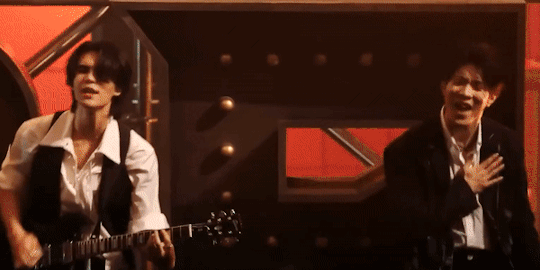

Call Me by Fire is a mainland Chinese TV competition show. They invite 33 established male celebrities with the goal to form an ultimate "boy band" by the show's conclusion. What tends to be the incredible pulling factor is they'll invite a combination of singers, musicians, actors, dancers, idols, presenters - incredibly well known faces in the industry - many of them hugely respected OGs in their field. (The demographic is usually late 20s+) so there's an intentional sense of maturity, experience and wisdom amongst the ensemble. The emphasis isn't really on forming this 'fictional' boy band, it acts as a mechanism for us to get more up close and personal with these artists. Allowing viewers to appreciate their creative genius, as well as who they are as people.
This show came as a spin off of another series 'Sisters Who Make Waves' which has the exact same premise but for female celebrities. Because it became such an instant hit, they made a male version shortly after.

As a Chinese speaker, I've been watching both shows since they started in 2020. Both are in their third season (with Call Me by Fire broadcasting right now). This year they've decided to include more participants (of mainly Chinese/Asian descent) from America, Korea, Japan, Vietnam and Thailand - along with the majority from China, Hong Kong and Taiwan.
Why I find this show both incredibly entertaining and compelling is because you get to watch spectacular collaborations between some of the most talented artists of this generation, and witness them embark on a journey of brotherhood through a shared love for performance (they live, work and perform together for the duration of the show). For me, theres also a massive nostalgia factor, because a large portion of these artists will be people I grew up watching.
There will be a lot of new attention on this show due to the Jeff's involvement (whose dubbed ‘Luo Jie Fu’ in Chinese). We’re only on Episode 2, and he's already making a huge impression, earning one of two MVPs spots after their first live performance - his group ranking 2nd out of 8, and his personal ranking being 7th overall (based on the live audience popularity vote).
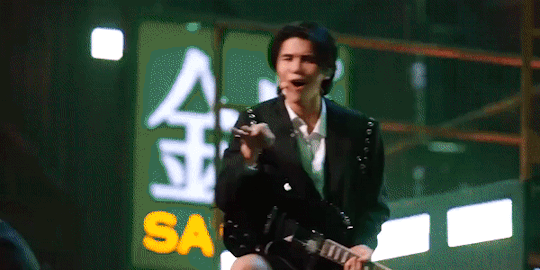

The show is uploaded onto Youtube in full (post-broadcast on a Saturday). Just to warn you, the episodes are usually very, very long (sometimes between 2-3 hours in total), but I personally really enjoy that. There are English subtitles but the translations don’t always capture the nuances.
Jeff is doing a superb job so far and he's very brave for taking this on. He brings something distinctly unique in his showmanship and personal sense of style. It's a daunting prospect for someone who can't speak or understand Chinese, but the other brothers are doing their best to help him feel as welcome and settled in as possible.
If anyone has any questions about the show or clips featuring Jeff they'd like to know more about, I'm more than happy to translate.
#call me by fire#call me by fire s3#jeff satur#chinese tv#how much charisma does jeff have?#YES#yes to everything basically#the boy was born to perform
136 notes
·
View notes
Text
MOST POPULAR NERDY PRUDES MUST DIE SONGS
While we wait for the soundtrack to arrive on Spotify/Bandcamp, etc, we can still see the listening stats for those uploaded on Youtube, specifically the Original Cast Recordings (OCR) and the Live Recordings (Live).
As a whole, the OCR playlist is more popular, with a median of 256k views per song and 3.4k likes, but those high views come with a like:view ratio of .006.

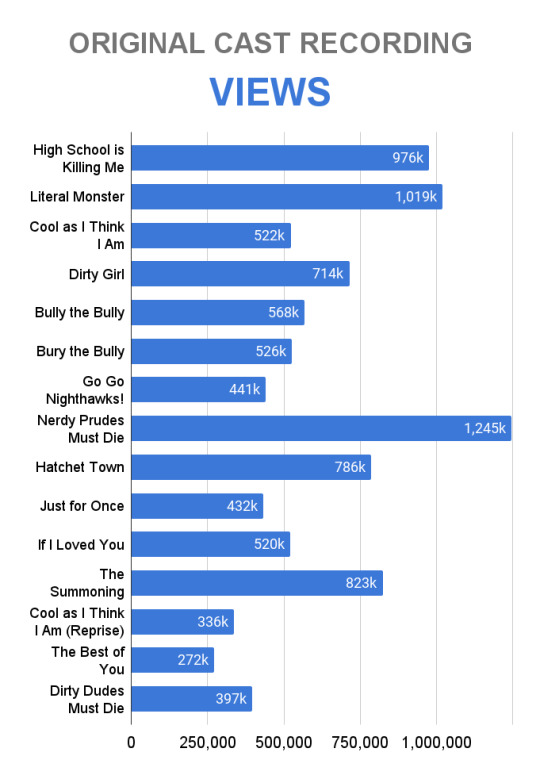

The Live playlist is visited more for one off songs, and likely not listened to all the way through. It has a median of 26k views, 500 likes, but a like:view ration of 0.018 (3x higher than the OCR).
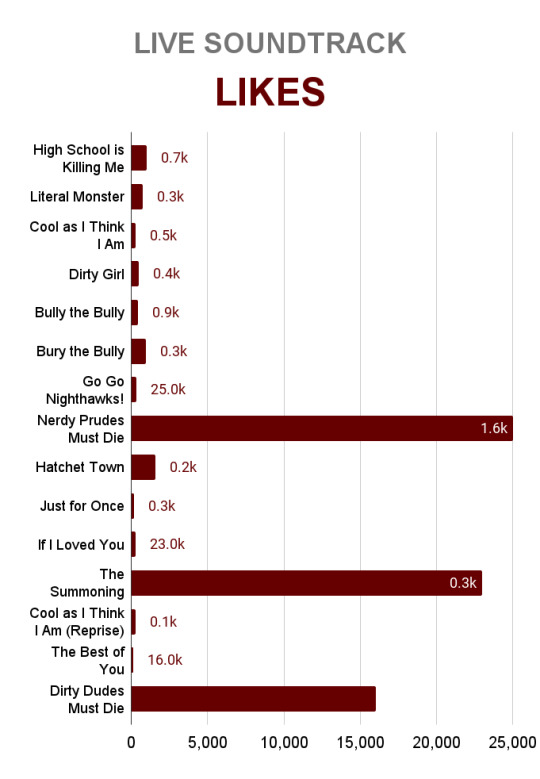

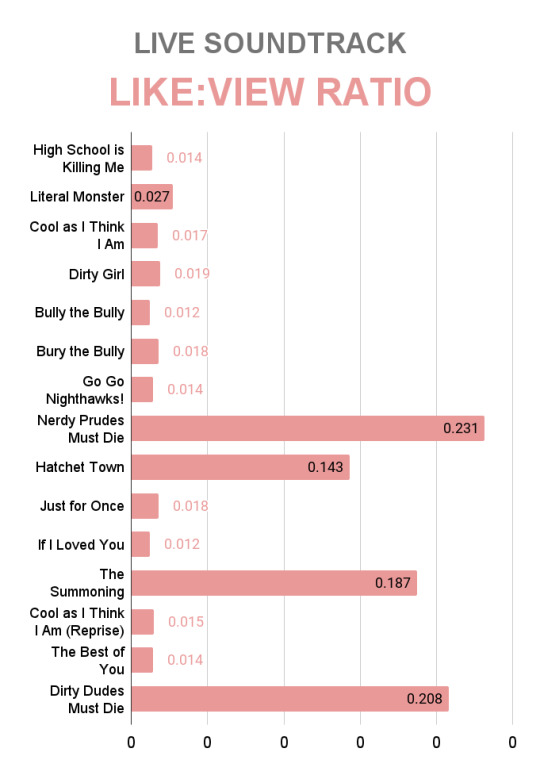
Obviously we can see some clear winners here: Nerdy Prudes Must Die, The Summoning, Dirty Dudes Must Die, Hatchet Town, as well as High School is Killing Me and Literal Monster, which have the added benefit of being the first songs in the show. Hatchet Town is an interesting case by having medium-low views & likes, but a high like:view ratio—not many listen, but those who do? They love it (or at the very least are pay apt attention).



If we want to combine all these factors, we get something like this, which can get a good overview, but is chaotic to look and and doesn't convey the nuances of each song across the categories.
So let's instead look at the rank of the songs! Because these graphs are very fun but take hours to make.
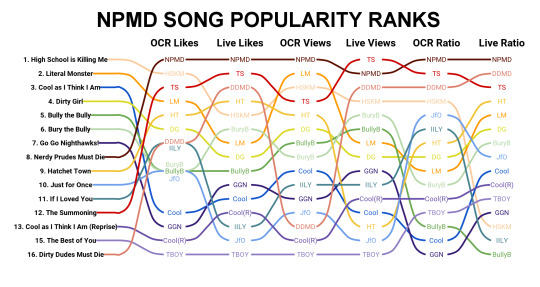
Here, we can see their movements a little clearer.
-----
Anyway, that's it from me! Nerdy Prudes Must Die's most popular song is Nerdy Prudes Must Die (very fitting).


Although it is very funny to me that it's mostly just the 3rd act of the song that is listened to
#my favourite song is probably the first two ngl#cool as i think i am is criminally underrated tho#i totally thought itd be more popular#my rambles#npmd#starkid#nerdy prudes must die#hatchetfield#hatchetverse
22 notes
·
View notes
Note
hi there! apologies for the incoming wall of text, but this should be pretty well within your wheelhouse, at least:
i've fallen into a rabbit hole of trying to triangulate the most specific point at which akechi switches from using "Kurusu-kun" to using "Akira" to address joker. the main thing is that the variables are confounding -- the way most people play (like me and literally everyone on youtube), rank 6 is on 9/3 (still "Kurusu-kun"), and the next time you're likely to see akechi in a context where he addresses joker by name is after he's been recruited *and* is ready for the next ranks of the confidant (at which point it's "Akira"). so, related to that, i was wondering if you had any insight/sources on a few points.
first, in your "When does Akechi start using Joker's given name?" post, you mention that on 9/21 (outside of penguin sniper) he still refers to joker as "Kurusu-kun." do you have a source on this, and am i right to assume the implication is that this is observed after completing rank 6?
more generally, i'm curious about various combinations of confidant-rank and plot-progression when it comes to his greetings outside of penguin sniper. e.g., if you haven't gotten rank 6 by november (and in fact, i think you're locked out of completing it at that point? someone mentioned a 10/22 deadline for it), or if you talk to him after rank 6 but before recruiting him (as in your aforementioned 9/21 observation).
one last thing: akechi's dialogue on the train platform in the morning on 11/2. he uses "Akira" as an address here, firstly, and it's basically the only time he does so pre-third-semester outside of the confidant / overworld greetings; secondly, it seems this interaction is new to royal. given that it's new, i wonder if it's conditional on having reached rank 6 (i.e., you won't get the platform scene unless you've maxed the confidant so far), since the discussion seems to lead directly into rank 7 that evening.
TL;DR: very curious about teasing apart what happens because of completing rank 6 vs. what happens because of plot progression, and it's pretty fascinating just how hard it is to separate the two factors.
if you come up with anything, even just a confirmation of the 9/21 thing, thanks!
[here's that original post to keep it all together]
Hi! Don't overlook that you can always visit Akechi in Kichijoji. If he's there, he'll have a brief exchange and tell you he's busy etc if you can't do a confidant event with him.
Yes, the reference to 9/21 means this is after conf 6. Akechi switches from e.g. Kurusu-kun to e.g. Akira after he joins the team. The first use of it is on 10/31, outside Penguin Sniper—the first opportunity you have to run into him after your first foray into Sae's Palace, on 10/29. It is date-dependent; it's not dependent on conf 6.

The first opportunity you have to meet him in Kichijoji before that is on 10/22, when you're still <family name>-kun:
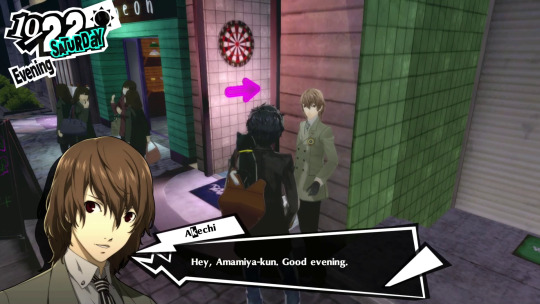
As far as whether there's a 10/22 deadline for conf 6, I don't know. I'll add it to the heap. The screenshots above were taken with conf 6 achieved. Like I mentioned above, 10/22 is the last time Akechi is available for a confidant rank-up before 10/31—"Honey, I'm home", the Shujin culture festival and blackmail, his admission to the team and the first entry to Sae's palace all happen in that interval. Akechi does not call the protagonist by name on 10/24 ("Honey, I'm home"), or, as far as I can tell, at any point before that Kichijoji meetup on 10/31. I think it's unlikely there are more complex mashups, simply because the script doesn't look that way:

{F1 81} is the family name (usually Kurusu or Amamiya); {F1 82} is the given name (usually Akira or Ren). Akechi has four possible greetings here. The first ("Hey, Kurusu-kun") goes to 10/22; the second, ("Oh, Akira") goes to 11/17, which is your last chance to do his confidant. The third ("Oh, it's you") is used throughout the third semester. I haven't been able to trigger the fourth ("Hey, Akira"); it may be unused.
Why do I think these may not vary? Simply because there are other F-codes like this, used as placeholders when someone's name changes based on a condition. Here's Muhen on Retro Street in Kichijoji:

That mysterious {F1 E2} is Muhen. But he's referred to by an F-code, because his name changes: before you do Akechi's conf 4, he's "Jazz Club Manager", but after you meet him during that conf 4, he becomes "Muhen". He has a special code that tests that condition.
But Akechi's chats only reference the protagonist's name directly. So my inclination right now is possibly, but probably not. Of course, it's possible the chat that picks the greeting from that set of four is where the logic is, so I wouldn't rule it out.
The train station meeting on 11/2 does lead in to conf 7, but the "Akira" address isn't dependent on conf 6—it depends on the 10/31 switchover we've already discussed:

Again, the given name is hardcoded; it doesn't appear to test the confidant level, like Muhen's.
other notes
Akechi also uses Joker's given name in the engine room—"I wonder why we couldn't have met a few years earlier, {F1 82}..."—and again, the {F1 82} code is hardcoded.
The only point I'm aware of when he doesn't do that is 1/2, when he walks into Leblanc and tells Sojiro he wants to speak with "Kurusu-kun". He reverts back to Akira, though.
58 notes
·
View notes
Text
The Challengers Are Real: An Introductory Post to the ATP Challenger Tour
A more compact version in the form of a Twitter thread can be found here.


Mike Faist (left) and Josh O'Connor (right) play Art Donaldson and Patrick Zweig in Challengers, portraying New Rochelle Challenger 2019 (📸 Challengers official trailer on YouTube)
If anyone comes here from the Challengers movie starting Zendaya, Josh O’Connor, and Mike Faist, which plot centered on a former Grand Slam tennis champion who registers to compete in a Challenger-level tournament and is somewhat drawn against the former lover of his wife (and coach) after a losing streak, even minus the romance part (which might or might not be true off-court), the plot is reminiscent to the real-life occurrence as a player’s career might have winded down due to a lot of factors (that could even go hand-in-hand), most notably injury and loss of form.
The ATP Challenger Tour was established in 1978 with 18 tournaments (in more limited locations than today) to serve as a feeder system for the ATP Tour, where it often operates 24/7 with more than 180 events in 40 countries nowadays, with the potential to increase this year. Being likened to the Minor Leagues in baseball, with players playing better than the club players (including us), it is characterized as the place where people try to transition from juniors/college to the professional Tour, hanging on due to enormous factors that do not allow them to break through (just yet), and regaining the form they once had (especially for former top players), which are the reasons the Challenger Tour is often dubbed as “the real deal” instead of the main Tour itself.
Beware of the length. This is a possible long read as this fan article aims to introduce non-tennis die-hard/hipster fans or even casual/non-tennis fans to the real-life ATP Challenger Tour. It might be essay-ish, but it can be useful!
How Are the Events Organized?

The tennis tournament hierarchy (📸 self-illustrated)
As an intermediary between the players who are starting, hanging on, and approaching retirement, the ATP Challenger Tour is in the middle of the professional tennis tournament hierarchy. It is the second-tier tour to the ATP Tour tournament structure, hereby referred to as the main Tour, and the ITF World Tour Tennis (formerly Futures). In this regard, the Grand Slams, whose scale is higher than the main Tour tournaments, are overseen by the International Tennis Federation (ITF), as well as the aforementioned ITF World Tour Tennis and the tennis field in the Olympics organized by the International Olympic Committee (IOC). The Challenger Tour itself comprised as many as 196 tournaments in 2023 held in 46 countries in comparison to the main Tour's 64 tournaments in 29 countries, while the ITF World Tour Tennis tournaments had a whopping 571 tournaments in 73 countries as of 2023, strengthening its position as the fundamental pillar of the professional tennis for the development of the future tennis stars with the Challenger Tour as its in-between.
On another note, the rankings system in tennis is updated almost weekly (except for the 2-week-long tournaments both in Tour-level and Grand Slams) compared to golf, for example.

The ATP Challenger Tour logo banner that was placed in the net during the Lille Challenger earlier this year (📸 Lille Challenger official website)
Back to how the Challenger Tour works, even though it is frequently averaged between 1-5 tournaments per week, with the least being in the week of the Roland Garros/French Open qualification rounds (1 in 2023, which was the Skopje Challenger), they are currently divided through 5 tiers depending on the points won by the eventual champions according to the most recent reform starting in 2023, which are:
Challenger 50 is the lowest tier;
Challenger 75;
Challenger 100;
Challenger 125;
Challenger 175, usually held on the second week of the 2-week Masters 1000s (the highest Tour-level event after the ITF-sanctioned Grand Slams) and often likened to a 250 (the lowest Tour-level tournament in scale) for their heavy draws.
Compared to the Tour level, the Challenger-level calendar is revealed periodically (usually every 3 months) and is accessible through the ATP’s website. To add, a Challenger season lasts slightly longer than the Tour-level calendar, for example in 2023–which main Tour season concluded with the Nitto ATP Tour Finals on November 20 and the Davis Cup Finals Knockout Stages on November 27–where there are 4 Challenger tournaments in the week of November 27-December 3, which are located in:
Yokkaichi, Japan (outdoor hard)
Maspalomas, Spain (outdoor clay)
Maia, Portugal (indoor clay)
Temuco, Chile (outdoor hard)

Clement Tabur (left) and Marco Trungelliti (right) as the runner-up and champion of the Kigali 2 Challenger, respectively, which took place in the Rwandan capital in the beginning of February 2024 (📸 Imvaho Nshya)
The tournaments themselves take place in a variety of locations, which will be dubbed as "their own swings" by taking into account its frequent differences between the main Tour events, either by location or by surface. For example, looking at the past few years:
2024's Indian swing (a string of Indian Challenger events, in this context) started weeks after the Australian Open with the Chennai Challenger, followed by Pune, Bengaluru, and New Delhi;
Challenger's own indoor (hard/clay) season is separated into two, which are the beginning of the season on par with the Tour's pre-Middle East swing European indoor season (e.g. for 2024, Ottignies-Louvain-la-Neuve, Quimper, Koblenz, Nottingham 1, Cherbourg, Glasgow, Pau, Lille, and Lugano), with an addition of indoor clay Challengers like in Szekesfehervar (usually in March) and Maia (usually year-end), and toward the end of the season on par with the year-end European indoor season (as of 2023, e.g. Orleans, Bratislava 2, Hamburg, Ortisei, Bergamo, Helsinki, and Danderyd).
In addition, the North American circuit is notably divided into indoors at the beginning of the year (e.g. for 2024. Cleveland; and add Rome, GA Challenger in 2023) and after the US Open (most notably Charlottesville, Knoxville, and Champaign Challengers), and outdoors season with the concluded Indian Wells Challenger between the end of January and the beginning of February 2024, and while the Tour-level grass season came into a close, the outdoor hard-court in Palmas del Mar kick-started the summer hard-court season in 2023, but the Phoenix Challenger stood in between the Indian Wells and Miami Masters 1000s held in the former's second week;
Challenger Tour's own clay season, both European and Latin American, which will be explained in a separate section considering its prevalence and impact to the current tennis landscape;
Other than Tunis, another notable tournament held in Africa was the Kigali Challenger in Rwanda from earlier this year, which became the seventh African country to organize a Challenger-level event;
Challengers' Mexican swing, which differed from the 2 tournament stops on the main Tour as this featured several clay-court and hard-court tournaments;
The Challengers used to have some carpet tournaments based in Eckental and Ismaning, the former which was folded in 2022 due to budget and support constraints, with the latter being the sole carpet tournament of the Challenger Tour since then despite carpet tournaments still being played in the ITF (former Futures) level;
The Challengers' own Asian Swing, which spanned between the South Korean swing spread before the French Open (around April), with parts of the Chinese swing being added to the timeline in 2024 before its second chapter in between/after the US Open (September-November) in line with the main Tour's Asian Swing, added by the Japanese swing to close the year (per the 2023 calendar).
Speaking of the Tour being 24/7, there will be several weeks where tennis visibly never stops. For example, in the second week of April 2024 (Apr 8-14), there are tournaments in:
Busan, South Korea (outdoor hard, which commenced the first half of the Asian Challenger swing);
Split, Croatia (outdoor clay);
Madrid, Spain (outdoor clay);
Sarasota, Florida, United States of America (outdoor green/HarTru clay, which kicked off one-third of the US green clay court circuit pre-French Open);
Morelos, Mexico (outdoor altitude hard, which continued this half of the Mexican Challenger swing, which succeeded the clay-court tournaments of that swing).
Furthermore, there is also a possibility that the 4-5 tournaments held that week will be played on 3 different surfaces, mainly clay, hard, and grass, with the grass-court tournaments being a preparation for the Wimbledon Championships; however, all of the grass-court Challengers solely take place in the United Kingdom. For this year, an example of those weeks is the week of June 3 (the 23rd week of the year), where there are 5 tournaments played on 3 different surfaces, which are located in:
Surbiton, United Kingdom (outdoor grass);
Heilbronn, Germany (outdoor clay);
Prostejov, Czech Republic (outdoor clay);
Zagreb, Croatia (outdoor clay);
Tyler, Texas, United States of America (outdoor hard).
Challenger Tour's Own Clay Season

One of the most prominent Challenger-level clay tournaments in Buenos Aires, with a packed home crowd (📸 ATP official website)
Even though the main Tour events have their own clay swing during the Golden Swing (the South American clay-court events usually held in February before the Indian Wells and Miami Masters 1000s, the latter that is famously called the "Sunshine Double") right after the two said hard-court Masters 1000 tournaments (starting from the end of March until the beginning of June), as well as a mini-clay season after the Wimbledon Championships before the North American summer hard-court swing (between July-August), the clay-court season never stops in the Challenger Tour, especially South America.
Parts of the Challenger Tour in South America were initiated by former World No. 31 Horacio de la Peña called the Legion Sudamericana in 2021 as he pointed out the lack of opportunities for Latin American players to develop their game on their home soil. From there, he brought the South American tennis federations together (such as but not limited to Argentina, Bolivia, Brazil, Chile, Colombia, Ecuador, Peru, and Uruguay) that not only comprised the clay-court Challengers as they mostly grew up on clay but also featured the hard-court Challengers, such as the Brasilia and Temuco Challengers by the end of the last season (2023), leading up to the Australian summer hard-court season to start the following year. This generated a huge impact on the growth of Latin American tennis as this was supported by the immense passion of the local fans as proven by their well-attended events. For instance, in 2022 alone (a year after this initiation), Argentinean players won 23 Challenger titles and 14 South American players partook in the Australian Open qualification rounds, which increased three-fold compared to their 2021 Australian Open qualifications participation rate as there were 20 players from the region in 2023 compared to only 7 in 2021. The number also grew into 10 South American players inside the Top 100 as of April 29, 2024, in a group of 35 Latin American players inside the Top 300 by that time, and could possibly be higher as the year progressed.
On the other hand, the clay season in the other parts of the world (mainly Europe) spanned from before the French Open until almost the end of the year. For example, most of the 24 Challenger-level tournaments held in Italy were clay-court tournaments, which explained the steady rise of Italian tennis as they invested a lot in their players' development from the availability of the lower-level tournaments until the coaching department to add to their passion of sports in general. Some others took place in different parts of Europe, including another possible tennis powerhouse in the Czech Republic, where Challenger tournaments held there are mostly clay-court ones, thanks to their grassroots development as well that cultivates the passion for the game in them (including having tennis courts almost everywhere), hence there are (young) talents from almost everywhere in the country.
Detailed writing about the South American Challenger's clay-court circuit as part of the entire pre-Roland Garros/French Open qualification build-up article, dated from the beginning of the 2023 clay season, can be found here.
Broadcast

The Challenger TV advertisement on the ATP official website (📸 ATP official website)
The ATP Challenger Tour is broadcasted in a dedicated part of the ATP official website, free of charge and repeatable as long as there are no technical problems on their website. People could rewind and document their moments, from the most hilarious ones to the hottest tennis shots and points the players constructed. Starting at the beginning of this year, compared to what is commonly said as the “dodgy CCTV camera” stream that was used back in the day, the current streams have HD cameras, making the moments even more visible.
Interestingly, these past few years, several Challenger tournaments have also been broadcasted on the local televisions of the country (or a specific place) where the competition takes place despite only the main courts or the later rounds. For instance, the tournaments in Latin America are often broadcasted by ESPN (Star+), DirecTV, or TyC Sports (in Argentina), ORR in Austria, L’Equipe TV/BeIN Sports for some French tournaments, and recently, Tennis Channel 2 broadcasts the Phoenix Challenger as part of their attempt to broadcast more US-based Challenger tournaments.
Some upcoming sections might have contained the outline of select players' journey to the author's best knowledge and how the Challenger Tour and the recent enhancements from the ATP play a part in their careers. Out of plethora of tennis players, they are just (tangible) examples of the influence of this circuit before or during breaking through/coming back to the ranks.
Top Players and Emerging Talents
According to the ATP Rulebook, it is stated that within the top players, the Top 10 players 21 days before the first Monday of the ATP Challenger Tour tournament are prohibited from entering by all means possible, be it through direct entry, wild card, or Special Exempts, especially in the 75-175 categories. For those ranked 11-50 by then, they could enter the 175 category per their ranks 3 weeks before the said tournament, and the ATP also has to approve their wild cards should there be a proposal, receiving a limited amount of wild cards depending on the Challenger Tour and the Tour-level schedule for that week. However, those players ranked 1-150 by then are not allowed to enter the 50 category, with the players ranked between 51-150 can receive a wild card upon approval (especially 50-100, where they must have the same nationality as the tournament).


Former World No. 1 Andy Murray (left) with his Surbiton Challenger title (📸 LTA) and former World No. 4 Kei Nishikori (right) with his Palmas del Mar Challenger Title (📸 The Japan Times), all won last year
Usually, former top players partake in the Challenger Tour for numerous reasons, mainly returning from injury (or suspension, if any) and grinding to regain their form back, which often takes forever–or, in some other instances, it's the nearest tournament to say farewell (as a professional player) to the sport that raised them. One of the most prominent examples from the first category was from former World No. 1 Andy Murray, who made his return to tennis with a metal hip in the summer of 2019, where he also rebuilt through the Challenger Tour until he became a permanent fixture again several years later, including his participation in the grass-court Challengers to prepare for the bigger-scale tournaments, as he won the Surbiton-Nottingham Challenger double in 2023–and somehow found himself winning the Aix-en-Provence Challenger on clay months prior, and former World No. 4 Kei Nishikori, who returned from his injuries in Palmas del Mar Challenger 2023 as an unranked player receiving a wild card to partake, winning the whole tournament afterward to mark his comeback to the sport despite his inability to catch a break in between once again. Former World No. 6 Matteo Berrettini, who was sidelined for more than a year due to various injuries, came back to become the runner-up in the Phoenix Challenger weeks before winning his first ATP-level title in two years in Marrakech (250). Recently, Frances Tiafoe hit a rough patch since the end of last year, which extended to this year's clay season, where he takes a wild card to rebuild in the Cagliari Challenger (which is a 175) for the week in hopes of rebuilding the confidence missing from his game, starting his campaign in the next few days as he received a first-round bye.


Ugo Humbert (left) with his Metz (250) 2023 title (📸 Tenis Magazyn) and Jan-Lennard Struff (right) with his Madrid Masters 1000 2023 runner-up trophy (📸 Sport 1 Germany)
There were several other notable stories where they reached new heights after being unable to catch a break regardless of age (for the older players, they are often called "late bloomers"). Ugo Humbert, who repeatedly ended up injured within the past years, marked the beginning of his resurgence with the Rennes Challenger 2022 title, followed by surviving an almost 4-hour match to win the Pau Challenger 2023, as well as the Cagliari Challenger at the same year before making stronger runs in both summer grass and hard-court seasons, ultimately winning the Metz (250) title on his home soil to out-perform his previous career-high ranking of 25 attained back in 2021, now having the best ranking of 13 from April 15, 2024. While it might have been the end of the road for Jan-Lennard Struff, he picked up where he left off last year by reaching 3 Challenger-level semifinals before re-entering the Top 100 thanks to his Monte Carlo Masters 1000 semifinal appearance as a qualifier, followed by becoming the runner-up of Madrid Masters 1000 as a lucky loser. Proving the doubters wrong once again, he finally won his maiden ATP-level title in Munich (250), where he became the third-oldest first-time champion since the ATP Tour was established in 1990.


Pierre Hugues-Herbert (top) won the Quimper Challenger 2024 (📸 Ouest France) and Benoit Paire (bottom) won the Puerto Vallarta Challenger 2023 (📸 Noticias AL Mexico)
However, not everyone had a successful comeback story. While former singles World No. 36 and doubles World No. 2 Pierre-Hugues Herbert, who also completed his career Grand Slam in doubles with Nicolas Mahut rebuilds as this was written, his comeback was plagued by some setbacks and injuries until the middle of 2023, as well as some other issues in between. Right as he started to get the knack again after winning the Quimper Challenger 2024 and becoming the runner-up of the Naples Challenger, another setback occurred in taking care of his youngest son who had just undergone surgery. The struggle can also be felt for former singles World No. 16 Benoit Paire, who fell as low as being ranked 217 on February 2, 2023, due to several losing streaks. Even though he found some knack after winning the Puerto Vallarta Challenger 2023, followed by the San Benedetto del Tronto Challenger months later before closing his season by being the Maia Challenger runner-up, his rollercoaster results comprised the rest of his season, including another string of early exits to start 2024 that prompted speculations of his retirement after the Rome Masters 1000 and the French Open/Roland Garros based on his latest updates.


Patrick Kypson with his Cleveland Challenger 2024 title (left) and Steve Johnson with his Bloomfield Hills Challenger 2023 title (right) (📸 ATP Challenger Tour's official Twitter–1, 2)
Often, which is also applicable to emerging talents, these Challengers are also part of the reciprocal Wild Card Challenge for the countries holding a Grand Slam, for example how the green clay trio of Sarasota-Tallahassee-Savannah Challenger in the United States became an addition to the other red-clay events spread in the different parts of the world for the players from the United States to compete to earn Roland Garros/French Open wild cards as a reward of their performance (as well as for their French counterparts within their system made by their federation) or an equivalent challenge for their summer hard-court season to form the US Open Wild Card Challenge in addition to counting their performances in equivalent surfaces corresponding to the Grand Slams. For instance, this paved the way for Patrick Kypson, who earned both the French Open 2023 and the Australian Open 2024 wild cards thanks to his exceptional performance in the mentioned series of tournaments, backing the latter up with a title in Cleveland Challenger, as well as solid runs in Delray Beach (250) the week after to finally enter the Top 150 for the first time. In contrast, after winning 2 Challenger titles in Bloomfield Hills and Lexington, former World No. 26 Steve Johnson won the US Open Wild Card Challenge last year and received a wild-card to the US Open last year, which turned out to be his last appearance in his home Slam (since he is from the United States), as he decided to hang his racquet during the Indian Wells Masters 1000 earlier this year.
Today, young talents also benefit from the College/Junior/NextGen Accelerator Programs that speed up their rise, which will be explained right in the next section.
The College/Junior/NextGen Accelerator Programs


The Junior/College Accelerator Program diagrams (📸 ATP official website)
For some people who had outstanding junior careers or even collegiate careers (for the latter, it is now for those who attended the US universities, notably playing in the NCAA), they are rewarded with the College/Junior Accelerator Program to try their hands against the best of the game as early as they transition from junior/college to the professional Tour. This partly answered the previous concerns about players having difficulties transitioning between the junior and professional circuit while recognizing their immense potential at times, thus the necessity to promote the rise of young talents to build through these accelerated opportunities.
In this case, the stand-outs from juniors (mostly between 1-30 in the ITF junior rankings, as well as the junior Grand Slam champions and finalists), college (ranks 1-20 in the Intercollegiate Tennis Association/ITA rankings), and NextGen (for players aged 20 and under inside the Top 350 ranking range) by the end of each season will be allotted certain occasions (and select tournament levels) to play in the main draw of both the Challenger Tour (in this case, it is for junior and college) and the main Tour-level (which applies to the NextGen players), as well as the ITF World Tour Tennis-level (for the up-and-coming juniors in a certain ranking range as illustrated). This hopes to nurture their talent and improve their pathway to develop their game, thus elevating their progress through the higher ranks of the game.




Rodrigo Pacheco Mendez (top left, 📸 International Tennis Federation), Joao Fonseca (top right, 📸 ATP official website), Martin Landaluce (bottom left, 📸 Tennisnet.com), and Ben Shelton (bottom right 📸 On Running Switzerland) as one of the examples of rapid rises through or influencing the Accelerator Programs
Outside of these, making it more tangible, some people in this category notably received wild cards in their local tournaments that could also help their development as they only allotted limited occasions to use their junior rankings. This might be the case for former junior World No. 1 Rodrigo Pacheco Mendez, who received numerous wild cards in Mexican Challenger and Tour-level events within the past 2 years before finally making his Challenger-level quarterfinal debut this year in Acapulco, or another former junior World No. 1 Joao Fonseca, who also benefited through a combination of his junior rankings/wild-cards/direct entries between 2022 and 2023, paving him the way to become the Asuncion Challenger runner-up and in the main Tour, the Rio de Janeiro (an ATP 500-level tournament) quarterfinals on his home ground before forging his college eligibility (right before starting his academic year) to turn professional. In addition, another former junior World No. 1 in 2023, Martin Landaluce, who notably trained in Rafael Nadal Academy, also has his Challenger and main Tour-level participation a combination between most of the wild cards and direct entry apart from the direct entry when his ranking is sufficient, which started to pay off when he reached his maiden Challenger-level quarterfinals in Alicante last year before reaching his first Challenger-level semifinal in Tenerife 2 just several months ago.
For college, this might not be possible without Ben Shelton's rapid rise, who became a runner-up in 2 Challenger-level tournaments and won 3 back-to-back tournaments (Charlottesville-Knoxville-Champaign) in 2022, some of them through wild cards thanks to his potential being spotted after being crowned the champion of the 2021/22 NCAA Singles Championship when attending the University of Florida, solidifying his rise through his fourth-round appearances in the Australian and US Open before winning his first Tour-level title in Tokyo (500).
Behind the Scenes of the Real-Life Challengers

Billy Harris in front of his van, the vehicle he used to travel between tournaments for three and a half years (📸 The Times)
As of 2017, there are more than 14,000 tennis players (male or female) who tried to make ends meet. However, only a handful of them could make the cut in the world's best, undergoing an arduous journey to the top, and most were unable to continue due to travel and financial difficulties. The latter is crucial not only for them to participate in a tournament (and its related logistics) but also for them to be able to practice (with a coach or more), to recover (e.g. through physiotherapy), as well as numerous other necessities while on Tour. Often, some could not afford traveling coaches for this reason, and finding sponsors could also be a struggle for them to keep moving forward. These are some reasons tennis players are often regarded as independent contractors.
Generally observing, there are various examples from players to manage them, but not everyone can live the life depicted in the movie. Some might have ended up playing select tournaments a year, sleeping in a van for the nearest tournaments compared to any other accommodation options, or regrettably, resorting to match-fixing (which also became an extensive issue for tennis in general) due to the little points and prize money they receive in the lower-level tournaments before the ATP institutes the prize-money-related reforms as part of the Challenger restructuring in 2023, as well as the Baseline initiative (with the financial stability for the Top 150 being the goal) later that year.
Some who could not catch a break, for instance, suffering from continuous injuries, took ages to (re)build from where they left off, and those who could not take it any longer gave up playing the sport due to the "demands" needed to reach the top. In the latter's case, some turned out to be a coach (like Zendaya's character, Tashi Duncan), a real-life case for the example of Gianluigi Quinzi.
These days, thanks to platforms like YouTube (and other social media platforms), some players document their experiences through their vlogs (video blogs) starting from how to win their first ATP point, how to travel in between tournaments, as well as preparing for the said competitions, until analyzing their own matches. Some prominent examples came from such as but not limited to:
Simon Freund
Federico Coria (look up: Fede Coria)
Juan Pablo Paz
Fabien Salle
Felix Mischker (look up: Tennis Brothers)
Karue Sell (look up: My Tennis HQ)
Challenger Doubles

Marcus Willis/Christian Harrison, the winner of this year's Savannah Challenger (📸 WSAV-TV)
In addition to the singles sector, the Challenger Tour typically has a doubles sector. Interestingly, this is another cross-line between up-and-coming doubles specialists, who are the players who only play doubles for several reasons (which also includes doubling the joy, doubling the fun, and doubling the chaos altogether), and those who frequently play singles but frequently/occasionally play doubles as well. While sometimes the consideration comes from the extra prize money they could earn from the latter kind of players, some turned out to have equal potential in doubles just like in singles or vice versa (having their potential also spotted in the doubles scene before singles), often having higher doubles ranking than singles despite playing both (which could be the case for those like Orlando Luz and Daniel Cukierman). Speaking of doubling the fun and mess, the Challenger-level doubles matches can be as hilarious as exhibition matches, which was exemplified by the Little Rock Challenger 2023 semifinals between Alexis Galarneau/Nicolas Moreno de Alboran and Callum Puttergill/Kelsey Stevenson.
Somehow, some rising pairs also started their way here and made their waves, often by winning multiple titles. For instance, before their doubles break-up at the end of the US Open 2023, Julian Cash/Henry Patten notably won 11 Challenger titles, 10 of which were won in 2022 (including the year-end Maia Challenger), the last one being in the Sarasota Challenger 2023. There are also some notable up-and-coming pairs, with some also having their collegiate roots, such as Ryan Seggerman/Patrik Trhac, who won 7 ITF titles before winning 3 Challenger titles since they paired up last year, or Sadio Doumbia/Fabien Reboul, who became more prominent as they partner more often these past few years as proven by their 15 Challenger-level titles since 2019 and 3 ATP Tour-level titles since winning their first title in Chengdu (250) 2023. There is also a “rebirth” lore in former singles World No. 322 Marcus Willis, who announced his retirement in 2021 and decided to give the professional Tour one more go a year later as a doubles specialist, winning 3 Challenger titles by the time this was written with 2 different partners to kick off this season.

Harri Heliovaara/Lloyd Glasspool, one of the most notable Challenger doubles breakout (📸 LTA)
One of the other remarkable doubles breakouts from the Challenger Tour came from Harri Heliovaara/Lloyd Glasspool, who won 4 Challenger titles in 2021 and became a runner-up in 2 other tournaments before breaking out as an alternate in Rome Masters 1000 by reaching the third round before reaching the quarterfinals in the French Open, partnering for at least one more year before splitting after the Shanghai Masters 1000. Currently, Heliovaara plays with another rising doubles player in Henry Patten (who came to the scene with Julian Cash before their split), as Lloyd Glasspool plays with veteran Jean-Julien Rojer. Since watching Challengers is free, it is time to watch more (Challenger) doubles, just like Tennis Tribe campaigns for the main Tour as well.
The Challenger Fandom and How They Stan Players #OnTheRise


The full-house stands during the ATP Challenger Tour tournaments in Shenzhen (top) and Buenos Aires (bottom) (📸 ATP Challenger Tour, the latter via Buenos Aires Challenger)
The tennis fandom extends from the main Tour-level fans, which most people usually are, and the "die-hard" fans, some of whom are dubbed as tennis hipsters, which is a group of passionate fans who adore the players' grind in the lower-level tournaments (Challengers and ITFs), often preferring to watch or follow matches in that level, some of which being unstreamed, than the main professional Tour-level matches. They even have their own definitions of talents (= potential players) and goats (= greatest of all time), where the potential of these players is revealed as the year progresses and as the circuit runs regardless of age.
However, parts of the fandom are still being shadowed by people who occasionally/frequently bet on the outcomes of a game/set/match, some of which influenced match-fixing practices as mentioned in the previous sections. While betting seems tempting, as many warnings on responsible betting as there are, it is not encouraged (especially at the places where it is illegal) not only for financial reasons but also affects self-esteem, relationships, physical and mental health, work performance, and social life, which can harm family, friends, workplace, and communities, as evident in the broader tennis issue.
Interestingly, some tournaments are well-attended, with even the Challenger-level players and tournaments gathering more fans to appreciate the game and the grind. Some such examples are the Latin American events (e.g. in Argentina, Chile, and Brazil, among others), the French tournaments (where a famous chant “papapapapapapapapapa ole” is chanted, it must be either in French tournaments or involving French players), the competitions held in Italy and the United Kingdom as there are a handful of fans also watching the Challenger tournaments all the way in Japan and South Korea, as well as the recently-concluded (by the time of this draft) Kigali Challenger in Rwanda. Some tournaments have “free entry” in most parts of the day, while some tournaments have (at their local rates) more affordable tickets to attend the later days of the tournament. Some become passionate fans of a particular player/some players they followed or regularly attend the nearest Challenger tournament near them, and some can also be inspired to pick up the racquet and play several years after their attendance.
From this, the lower-level tennis fandom might not be as prevalent as the main Tour, but even without the gambling element, some become legitimate avid fans for their love of the game. They chase talents, find joy in their respective journeys, and are pleased should they break through or break even after hanging on for several years. This is in line with the ATP Challenger Tour’s #OnTheRise campaign, where they championed what is seen as a repetitive process of grinding, which represented hard work, perseverance, and discipline, paving the way to greatness. This is sometimes overlooked due to the (statistical) comparative nature between one player and another since there is also a perception that life is not a race, and everyone has their own path to the top, which tennis opens the gate to. Ultimately, for some “die-hards,” following the players from the start, all the effort, until they rise or become one of the legends is a pleasure. Sometimes, these fans also made sure “they are there for/until their last dance” when the player’s last-ever professional tournament played to honor their incredible careers, which marked their retirement from playing tennis professionally, took place in their nearby Challenger tournament, or those that made a significance in their careers. All those reasons are believed to be also behind the #WatchChallengersFolks campaign, which has been widespread on Twitter these past few years.
Important Links
ATP Challenger TV (free broadcast of the Challenger Tour matches)
ATP Challenger Tour annual calendar, updated periodically
Entry Lists (for Challenger-level and above to check on the participants of each event)
Live Rankings (real-time ranking estimates before the official rankings come out) (1, 2)
#challengers (movie)#challengers 2024#zendaya#josh o'connor#mike faist#new rochelle challenger#atp challenger#atp challenger tour#introductory post#WatchChallengersFolks#ChallengerMatters
12 notes
·
View notes
Text
Rachel Leingang at The Guardian:
In the last few months, Donald Trump has done interviews with rightwing Twitch streamer Adin Ross and a host of podcasters, including Dr Phil, comedian Theo Von, computer scientist Lex Fridman, and YouTuber Logan Paul – part of what the Atlantic has dubbed Trump’s “red-pill podcast tour”. He’s posted incessantly on his own social media platform, Truth Social. He did a live space on Twitter/X with the platform’s owner, Elon Musk. He talked with Fox’s Laura Ingraham and called into Fox & Friends and spoke to other Fox hosts and personalities. His media strategy aligns with the current state of the rightwing media landscape: Fox is still a dominant source, but for the most Maga-adherent, it’s not Trumpy enough, despite some of its hosts embracing election denialism around the 2020 US election. Instead, there’s increasing fragmentation thanks to influencers and lesser-known outlets built around Trumpism.
This is the first election since Tucker Carlson, once Fox’s loudest voice in a primetime spot, was reportedly fired by the network, and his solo ventures so far haven’t taken on the prominence he had on TV. It’s also the first election since longtime Republican heavyweight Rush Limbaugh died. These big changes have left holes in rightwing media, which were filled by an increasing cadre of influencers, content creators and smaller outlets. [...] Trump’s grip on rightwing media is ironclad, said Julie Millican, the vice-president of Media Matters, a progressive center that tracks conservative media. In the past, the Republican party and its candidates would follow what rightwing media did and align its policies that way – but now, the media follows Trump, she said.
“If you don’t capitulate to what Trump and his enablers and his supporters are looking for, then they’ll shut you out,” Millican said. Since his efforts to overturn the 2020 election, his influence has only increased, and “now he has a stronger control over the entire media ecosystem than he did previously”, she added. As rightwing outlets rise, the stories they cover differ more from what’s on mainstream news, furthering the bubbles a divided United States lives within. While in years past, you’d find different takes on the day’s news in left- and right-leaning outlets, you’ll now find stories that exist solely on rightwing media, Millican said.
[...]
TV news and rightwing websites
Traffic to news websites, including rightwing sites, is down compared with 2020. Howard Polskin, who tracks conservative media on his site The Righting, said a few factors play into the decrease. Facebook and other Meta social media de-emphasize news content now, sending less traffic to news outlets. And 2020 had several major news events colliding: a pandemic that kept people online more, nationwide protests over racial justice and a hotly contested election.
No single star has taken the place that Carlson or Limbaugh once held. Some conservatives told the Guardian they stopped watching Fox as often after Carlson left or because the network isn’t Maga enough. Fox agreed to pay $787m to settle a lawsuit from Dominion Voting Systems over defamation claims for spreading lies about the voting machine company’s role the 2020 election. Carlson abruptly left the network shortly after the settlement, and he has claimed his firing came as a result of the settlement. Fox denies that his removal had anything to do with the Dominion case.
[...]
Another paper, Epoch Times, a far-right and anti-China outlet associated with the Falun Gong religion, continues to rank highly among conservative news outlets despite a justice department lawsuit that alleges it operates as a money laundering and cryptocurrency scam. Its stories are often shared by rightwing politicians or influencers. “Their cultural impact and political impact seems much smaller than the distribution,” Polskin said.
Carlene, a 58-year-old from the Upper East Side who attended the Trump rally in the Bronx, said she gets news from the Epoch Times, Daily Wire and X and sometimes tunes into CNN and MSNBC to get the other side. “I watch less Fox News now after they got rid of Tucker Carlson,” she said. “It made me think Fox was just like everyone else.” For the less online Republican, talk radio shows, especially those that run the airwaves in rural areas, play a strong role in setting the conservative message. As newspapers in rural areas have shuttered, creating a crisis in local news, these radio shows are “reaching voters that aren’t tapped into the same media spaces that we often see in these large metropolises on either coast”, Tripodi said. To fill Fox’s void on TV, some conservatives have turned to Newsmax or One American News Network, which are farther to the right than Fox. “One American News Network and Newsmax did a very good job at establishing themselves as a place that would verify whatever Trump was saying,” Tripodi said.
[...]
Podcasts and influencers
Beyond television and news sites, a rightwing news consumer will find a growing landscape of podcasts, YouTube channels, Substack newsletters, documentary film-makers and social media influencers all trying to build a following. “For every laid-off journalist, another Substack is born,” Polskin said. “And that just … fractionalizes the news audience even more.” The top of the podcast charts on Spotify and Apple shows a host of conservatives: Shawn Ryan, Candace Owens, Carlson, Megyn Kelly. Ben Shapiro, the conservative commentator, has his own podcast, and his network, the Daily Wire, hosts some of the biggest rightwing pundits. “In terms of just influence and power in the media landscape, to me, he would be someone that’s at the top of that space,” Millican said. Polskin called Shapiro the “800lb gorilla of rightwing podcasts”. Charlie Kirk, the founder of Turning Point USA, is also a major player. His organization is focused on turning college-age people conservative, and he’s been on a tour around the country to college campuses in recent months, in addition to his podcast and social media presence.
[...]
While he doesn’t grab a huge share of the podcast market and he’s currently in prison for defying a congressional subpoena related to the January 6 investigation, Steve Bannon has an outsize influence on the right with his War Room show. He gets big-name rightwing politicians as guests and still has Trump’s ear, but he’s never cracked the top 20 in Polskin’s ratings.
The Guardian has a solid report on the rise of the Trumpian grip on the right-wing media and the further divergence from normal America, where conspiracy theories and lies dominate on any given right-wing show.
#Conservative Media Apparatus#Donald Trump#Charlie Kirk#Dr. Phil McGraw#Adin Ross#Logan Paul#Lex Fridman#Theo Von#Elon Musk#Fox and Friends#Tucker Carlson#Tim Pool#Benny Johnson#OANN#Newsmax#One America News Network#The Daily Wire#The Epoch Times#War Room#Stephen Bannon#Candace Owens#Megyn Kelly#Ben Shapiro
4 notes
·
View notes
Text
Jubilee, Rank #72 (a post-event reflection)

“Why would you post this on Nocturne’s 7th anniversary of its addition to Starlight Stage?” Because one, I like the song—especially the original duet. And two, screw it, we roll.
It has been a few weeks since the event ended, but I’ve been trying to write this reflection for weeks without trying to lose my mind over actually writing out several thoughts (both good and bad) over a collaboration event in a mobile rhythm/gacha game. Forgive me for the raw honest thoughts I’m about to say in there.
The Prologue

Hoshimachi Suisei is a virtual YouTuber (VTuber) affiliated with Hololive Production, one of the biggest virtual agencies for such talents. She is one of the earliest talents recruited by the agency, alongside other soloist VTubers like Tokino Sora, Roboco, Sakura Miko, and AZKi—together referred to as “Generation 0”. She is also someone striving to become an idol herself. Prior to becoming affiliated with her current agency, she had tried entering IRL idol agencies, to no avail. She tried joining Hololive Production, but got rejected. She got into INoNaKa Music, but would eventually get transferred into Hololive’s main JP branch in December 2019.
To briefly describe her activities: Suisei is a forever 18, multi-talented idol who has done (and sung) a lot of accomplishments over the years. She has interest in 2D idols as well, with her having interest in Ensemble Stars!! and THE IDOLM@STER, the latter of which being an inspiration that led her into her own idol journey. She would do covers alongside other Hololive talents with songs from those two series. “Honeycomb Summer”, “Melty♡Kitchen”, “Alive Factor”, “Hanamuke no Tori”… to name a few. There were also times where she would often be pulling in the respective games’ gacha, often spending a lot of money on them. Her favorite idols from Enstars!! and IM@S include Ritsu Sakuma, Natsume Sakasaki, Hayate Hisakawa, and Kaede Takagaki.
Six years after her debut, she would perform with her own tantou.
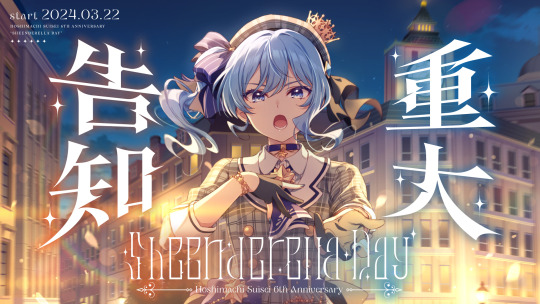
At Suisei’s 6th Anniversary 3D live, appropriately titled “SheenderellaDay”, a certain someone would perform with one of her fans.
The song? It was “Koi Kaze”.
Suisei shared the same stage with no one other than Kaede Takagaki, who was in her 1st SSR outfit. This was followed up by a small MC corner. Kaede switched into her 4th SSR outfit, and then a new song written by Suisei’s recurring composer, lyricist, and fellow Midnight Grand Orchestra member TAKU INOUE started playing on stage. As the concert was happening, I was merely saying “congrats” in my mind.
And thus, the grand “Jubilee” started.
The Event (and My Mixed Feelings)

It’s easy for me to say that among the people who wanted a Hololive collab with THE IDOLM@STER in-game, Suisei probably won the hardest. She got her own in-game event, original song, a commu, and even an SSR in the series she loves—ignoring the behind-the-scenes shenanigans we will probably never fully know about. There were previous Hololive collab events in other gacha games, with Tokyo 7th Sisters and Granblue Fantasy getting their collabs in the past few years, but when it came to Starlight Stage’s collaborations, this was the game’s most intense collab yet.
I… didn’t initially plan on running this event much. While I was initially excited by the intensity of the collab event upon its official announcement, there were lingering feelings of “what if this were to be my tantou idol’s last event” and a slight hint of disappointment. The “end” of Starlight Stage had become a recurring topic among English-speaking Ps ever since the so-called “content reduction” announcement was released before the end of 2023. The collaboration itself was teased in that same announcement, but I presumed that the things around the collab were already in production as the whole “content reduction” stuff was being decided. The thought of losing IM@S’ most profitable mobile game because of whatever Bandai Namco is up to is kinda scary. It’s a silly sentiment towards a live service mobile game that will shut down eventually, but the thought is also real.
Then, there’s Kaede herself. Her last token event (and unit from the original mobile game) in Deresute, “Pretty Liar”, was held back in 2018. There’s… things I could say about her content released after that, both things I liked, things I felt odd towards, and things I didn’t really like all that much. In a nutshell: I want to see Kaede as “herself” and not just as the “final boss” Cinderella Girl that she is. It’s complicated.
And yet, this event’s timing couldn’t have been even more perfect. Lately I’ve been finding March and April to have moments involving my tantous. The event’s duration overlapped with March 30 (one year since Cinderella FES Mizuki’s release and eventually sparking FES Kaede in that same banner) and April 2 (10th Anniversary Tour Final, aka the live that changed the trajectory of my producing life forever). And the whole thing took place during Holy Week break, no less. The only real issues I would’ve had were potential connection issues that may arise in a then-upcoming 3-day road trip.
Why did this event have to be 11 days long?
The Actual Grind
Day 1 of the event started with me messing around with all my early intense grinding. I managed to get around the top 20 within the first 30 minutes of the event. Trying to maintain a top 100 spot was hard during the first few days, but eventually things stabilized as the days went on.
For a short break during the first day, I pulled on the collab gacha. My Suisei gacha tickets didn’t give me too much and got me an off-rate SSR (Miyo1), so I resorted to using jewels. Here came Kaede’s collab limited SSR, fully animated. My jewel count went from 55k at the start of the event to 36k—which would eventually be thrown into event ranking hell instead of being saved for the Kaede7 reruns (which was its own story).

During day 2, I kept playing (actually sending my auto Grand team through EVERLASTING FORTE hell and back) while I was at a local convention for the whole afternoon. Not pictured: me showing fellow artists there that I was playing the event! I may have fallen out from my goal for a while, dammit, but I kept farming for tokens anyway.
In addition, I drank some coffee especially during the last few days, although sometimes I find myself feeling a bit sleepy…
Throughout days 6-8, I was stuck on the annual provincial road trip during Holy Week. I brought two phones through the whole thing: my main phone whose mobile data has been mostly spent on event grinding, and a side phone where I would often chat on Discord or play videos and music during the trip. During the second night, I did get to stay in the hotel room by myself (we had two hotel rooms) and took that opportunity to try staying awake.
On day 9, I hit the 99,999,999 money cap for the first time. Nothing too significant about it other than me having to spend a lot on stuff from the limited money shop. (That’s why gold bars exist in-game!)
The final two nights had me trying my damn best to stay up for as much as possible past 1 or 2 AM. If you really value your sleep and sanity over a dumb number for a popular idol’s event, I do not recommend this.
The last day of the event was quite a stressful trip. Within the final 24 hours, I wanted to try reaching the maximum amount of tokens you could hold (99,999 tokens) but I feared that there would not be enough time for me to reach the target. I ended up stopping the EVERLASTING FORTE grind as soon as I got to 90k.
I wanted to park at certain numbers related to my tantous (Ray Distance’s Mobamas debut date, the day CG 4th LIVE’s performance of Nocturne happened, etc.) but I wouldn’t have enough time and/nor tokens to actually reach those numbers. Near the end I tried getting 1,591,715 (Mizuki and Kaede’s respective heights) but in the end, I only managed to reach the 1.59 million point mark with the last tokens I grinded and spent.
The hardest part of the event was actually trying to keep that high amount of uptime, and it was more apparent when I would get knocked out as I was trying to stay awake. I have a terrible sleep schedule (or lack thereof) but my sleepy butt wouldn’t keep me awake for too long. The loop of pressing buttons every 2 minutes felt monotonous for 11 days straight, minus the part where I actually played the event song for either jewels or to get a high score.
My complicated feelings towards Kaede’s latest event song being a collab with a popular VTuber was stuck in my mind, and I first thought I would try to settle for Top 500 early on; but previous sentiments and “final event” anxiety, combined with some encouragement from friends and other Producers (who ranked with me) kept telling me to keep going.
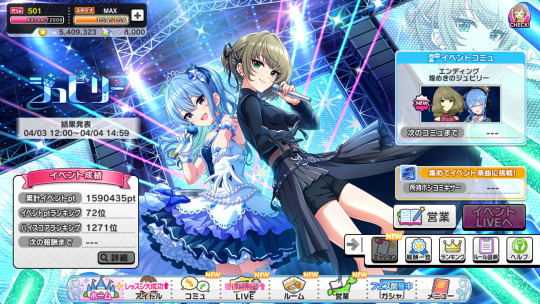
I ultimately finished the event at rank #72, which is… certainly a number associated with ChihayaPs. With a total of 1,590,435 points. I saw the numbers on Haruka’s birthday (April 3), send help.
I also made it to SSS rankings for the first time. It’s something I never really cared for, usually, but apparently ranking very high in a token event would let you in the top 1000. I never saw my actual SSS rank at the end of March (since I was too busy grinding), but I probably made it in the top 500 in the 91st SSS ranking that month.
The Tantou Unit Revenge
There’s one last thing I want to talk about, something I’ve been preparing for almost a year by that point. Long story short: I wanted to tier for the units I produce, and for the idols that are closest to me. I wanted to do that with S.E.M (my first tantou unit), but over the last few years my chances kept fading with each SideM game that got killed. By the time Growing Stars leaked announced its shutdown, I ended up starting to ask for a Kaede and Mizuki event (as Ray Distance) for me to tier in for me to have some form of “revenge” and (hopefully) closure on that front.
Of course that dream event didn’t happen (yet), knowing how much Bandai Namco and Cygames likes putting that After20 duo (who also have some of the busiest VAs in the series) together sometimes.

Over 2023, I did get some top 2000s here and there, in both token and groove events. The last event with my actual tantous in it happened over a year ago (Heartboiled Wars with Tomoe). Every event I’ve tiered in has had an idol I like: Aki, Sanae, Airi, Kanade, and Koharu.
And yet, I didn’t tier in this event because I like Suisei… I tiered in this event because I like Kaede. So much that I ended up producing her.
As weird as I feel about the collaboration as a whole, giving up on this chance would’ve left me with intense regret for several reasons. Future me would be really disappointed if this is to be Kaede’s final Starlight Stage event. (So I hope she gets one more event after this…)
The possibility of me failing a chance of tiering one of my closest tantou’s events again scared me. I lost my chances more than once, and it would probably hurt if I give up that chance. It wasn’t the ideal event I wanted to try in, but the timing was too perfect not to ignore either. There were many thoughts swirling in my head throughout the whole thing, but then again… it’s a tantou event in the end.
I’m awaiting Mizuki’s next event (especially since she hasn’t gotten a new song for nearly 3 years now), but I need to recover first.
Despite everything…
In the end, I do not regret being Kaede’s producer.
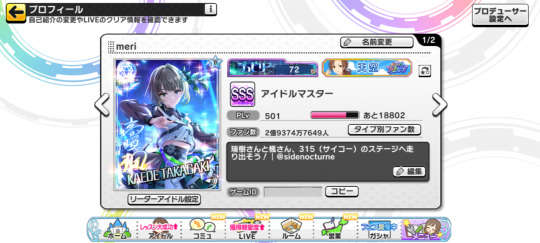
The Stats
PLv: 347 → 501. The 2x fan campaign combined with a bit of the EXP Produce perk boosts may have helped a lot.
Jewel count: 55k (pre-gacha) → 36k (post-gacha) → 7k. Thank goodness I didn’t have to spark Kaede in that limited banner.
Idols made past 15 million fans: Uzuki, Takumi, Nanami, and Tomoe. Three of my tantous & an excessive use of Nanami’s FES SSR.
Idols made past 10 million fans: Seira, Yui, and Koharu. Sanae, Miku, Nana, Ranko, and Karen also got a significant boost in fans due to all of this.
SSS songs cleared: Gaze and Gaze. Been wanting to save getting that clear for a special event.
Stamina drinks spent: everything.
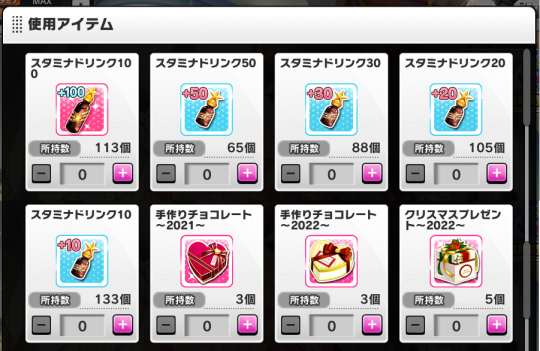
Total no of EVERLASTING FORTE plays at the end: 2,947.
SSRs obtained from collab gacha: 5 (two Kaedes, one Rin4, a Makino1 dupe, and a Miyo1.) I’d eventually gain another 2 SSRs after the event (neither of them were Suisei though. I had to resist pulling further because a Kaede7 rerun was coming…)
The Special Thanks
The KaigaiPs that ranked with me in the top 100 (Zhu and Shiina especially—those two are on a different league of their own) for helping me survive this tiresome first Deresute T100 attempt.
My fellow online friends from the various Discord servers and on Twitter, for supporting me. I’ve been keeping that whole thing under wraps from my main account out of embarrassment, but yeah.
The Hololive Fan Wiki, Virtual YouTuber Wiki, and the JP Hololive Unofficial Wiki for Suisei research.

As a final note… when’s Passion Jewelries? Or the next Kaede/Mizuki event?
9 notes
·
View notes
Text
"I have worked on this article on and off over the past half year or so. I started it right after my club’s tournament Revolution Rumble, because I was fascinated by the variance of skill in the tier of almost all unrated fencers, and also how that shook out in terms of HEMA rating. This led to a bit of a deep dive into how HEMA ratings works, what it’s good for, and what it isn’t. Because of that, I have decided to make this the first of a three part series about HEMA ratings. The second part will be about why HEMA ratings is not the best system for a world ranking, and the third part will be about how the pandemic affected the ratings. I’m sure I will talk more about HEMA ratings beyond this, but that’s all I have in the immediate future.
HEMA Ratings Series:
Part 1: Tiered Tournaments and Unrated Fencers
Part 2: World Ranking
Part 3: Covid Recovery"
An interesting piece on how to approach tiered tournaments and why. Not relevant to every historical fencing practitioner, but a useful read for any tournament organizer looking to consider the various relevant factors.
For anyone who hasn’t yet seen the following links:
.
.
.
.
Some advice on how to start studying the sources generally can be found in these older posts
.
.
.
.
Remember to check out A Guide to Starting a Liberation Martial Arts Gym as it may help with your own club/gym/dojo/school culture and approach.Check out their curriculum too.
.
.
.
.
Fear is the Mind Killer: How to Build a Training Culture that Fosters Strength and Resilience by Kajetan Sadowski may be relevant as well.
.
.
.
.
“How We Learn to Move: A Revolution in the Way We Coach & Practice Sports Skills” by Rob Gray as well as this post that goes over the basics of his constraints lead, ecological approach.
.
.
.
.
Another useful book to check out is The Theory and Practice of Historical European Martial Arts (while about HEMA, a lot of it is applicable to other historical martial arts clubs dealing with research and recreation of old fighting systems).
.
.
.
.
Trauma informed coaching and why it matters
.
.
.
.
Look at the previous posts in relation to running and cardio to learn how that relates to historical fencing.
.
.
.
.
Why having a systematic approach to training can be beneficial
.
.
.
.
Why we may not want one attack 10 000 times, nor 10 000 attacks done once, but a third option.
.
.
.
.
How consent and opting in function and why it matters.
.
.
.
.
More on tactics in fencing
.
.
.
.
Types of fencers
.
.
.
.
Open vs closed skills
.
.
.
.
The three primary factors to safety within historical fencing
.
.
.
.
Worth checking out are this blogs tags on pedagogy and teaching for other related useful posts.
.
.
.
.
And if you train any weapon based form of historical fencing check out the ‘HEMA game archive’ where you can find a plethora of different drills, focused sparring and game options to use for effective, useful and fun training.
.
.
.
.
Check out the cool hemabookshelf facsimile project.
.
.
.
.
For more on how to use youtube content for learning historical fencing I suggest checking out these older posts on the concept of video study of sparring and tournament footage.
.
.
.
.
The provoker-taker-hitter tactical concept and its uses
.
.
.
.
.
Approaches to goals and methodology in historical fencing
.
.
.
.
.
A short article on why learning about other sports and activities can benefit folks in combat sports
.
.
.
.
.
Consider getting some patches of this sort or these cool rashguards to show support for good causes or a t-shirt like to send a good message while at training
13 notes
·
View notes
Text

1. Understanding YouTube SEO
YouTube SEO is the process of optimizing your videos to rank higher in YouTube’s search results. Like Google, YouTube uses an algorithm to determine which videos are most relevant to users’ searches. The key ranking factors include:
Watch Time: The total time viewers spend watching your video.
Engagement: Likes, comments, shares, and subscriptions.
Relevancy: How well your video matches a user’s search query.
2. Keyword Research for YouTube
Keyword research is the foundation of YouTube SEO. It helps you understand what terms people are using to search for content similar to yours.
Use Tools: Tools like TubeBuddy, vidIQ, or YouTube’s auto-suggest can help find the right keywords.
Focus on Long-Tail Keywords: These are specific, less competitive phrases that help your content rank faster. For example, instead of "yoga," you might use "beginner yoga for back pain."
Analyze Competitors: Look at the top-performing videos in your niche to find keywords you can use.
3. Optimizing Video Titles
Your title is the first thing viewers see. It must be both engaging and SEO-friendly.
Include Keywords: Your primary keyword should appear naturally in the title. Example: "Yoga for Beginners: Relax and Strengthen with This 20-Minute Routine."
Be Concise: Keep it under 60 characters to ensure it's fully visible.
Create Curiosity: Titles that promise value or solve a problem encourage clicks.
4. Creating SEO-Friendly Descriptions
Video descriptions help YouTube understand your content, making it easier to rank.
Write Detailed Descriptions: Aim for 250-500 words. Include your target keyword in the first 100 characters and sprinkle it naturally throughout the text.
Include Secondary Keywords: Use related keywords to further improve SEO.
Add Timestamps: Break down your video into sections with timestamps to improve user experience and help with ranking.
5. The Power of Tags and Hashtags
Tags and hashtags are a hidden gem for YouTube SEO.
Use Relevant Tags: Add 10-25 tags, including your primary keyword and variations of it. Example: "beginner yoga," "yoga for back pain," "morning yoga."
Leverage Hashtags: You can add hashtags in your title or description to improve discoverability. Ensure they’re relevant to the content, e.g., #YogaForBeginners.
6. Custom Thumbnails for Higher CTR
Your thumbnail is like a billboard for your video. A custom, high-quality thumbnail increases the click-through rate (CTR).
Use Bright Colors: Bright, contrasting colors grab attention.
Include Faces and Emotions: Thumbnails showing human faces tend to get more clicks.
Add Text Sparingly: If you add text, make sure it’s short, bold, and readable even on small devices.
7. Enhancing Viewer Engagement
Engagement signals are critical for boosting rankings.
Encourage Interaction: Ask viewers to like, comment, and subscribe at key moments in your video.
Use End Screens and Cards: These features allow you to promote other videos or playlists, increasing watch time and session duration.
Polls and Questions: Use YouTube’s interactive features like polls to engage your audience.
8. Optimizing Closed Captions and Transcripts
Closed captions and transcripts enhance SEO and accessibility.
Closed Captions: They help non-native speakers and those with hearing impairments. YouTube’s automatic captions aren’t always accurate, so upload your own if possible.
Transcripts: Post the transcript of your video in the description. This makes your content more searchable and helps with keyword relevance.
9. Utilizing Playlists for SEO
Playlists group related videos, improving watch time and SEO.
Create Keyword-Rich Playlists: Organize your videos into playlists using relevant keywords. Example: “Yoga for Beginners,” “Advanced Yoga Poses,” etc.
Boost Engagement: Playlists encourage viewers to continue watching your content, thus improving session time and video ranking.
10. Boosting Watch Time and Session Time
Watch time is one of the most significant factors for YouTube rankings.
Hook Viewers Early: The first 15 seconds of your video are crucial. Use an engaging intro to capture attention right away.
Deliver Value Consistently: Keep your content informative and engaging throughout. Aim for 5-15 minute videos, depending on your topic.
Maintain Session Time: Session time refers to how long a user stays on YouTube after watching your video. Encourage viewers to explore your other content using playlists and end screens.
11. Promoting Your YouTube Videos
Even with SEO, promotion is essential for gaining traction.
Share on Social Media: Post your videos across platforms like Facebook, Instagram, Twitter, and LinkedIn.
Embed on Websites and Blogs: Embed your videos in relevant blog posts to drive traffic from your website.
Collaborate with Other Creators: Partnering with YouTubers in your niche can expand your reach and introduce you to new audiences.
12. Analyzing and Improving with YouTube Analytics
YouTube Analytics is your best friend for tracking performance and making improvements.
Monitor Key Metrics: Track watch time, CTR, audience retention, and traffic sources. These give insights into what’s working and what needs improvement.
Adjust Keywords and Content: If a video isn’t performing well, consider revising your title, tags, or description, or try promoting it again.
Experiment with Different Content Types: Use analytics to identify which video formats (tutorials, vlogs, etc.) resonate most with your audience.
YouTube SEO is an ongoing process, but when done correctly, it can significantly boost your video rankings and channel growth. By focusing on keyword optimization, engagement, and promoting your videos across platforms, you can increase visibility and watch time. Start implementing these strategies today, and watch your YouTube channel thrive!
#youtube#seo#youtube seo#digital marketing#search engine optimization#seo services#youtube video#video promotion#video seo
3 notes
·
View notes
Text
Why Short Videos Work Best: A Simple Guide for 2024
Short videos have taken center stage in digital marketing due to their ability to capture attention and engage audiences effectively. This blog explores why short videos work, their benefits, and how brands can use them successfully.
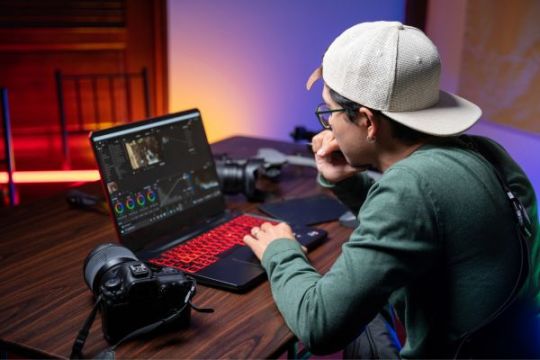
1. What Makes Short Videos So Effective?
Short videos resonate with modern audiences because of these key factors:
Attention Spans Are Shrinking: People consume content quickly, making short videos ideal for grabbing attention in a few seconds.
Snackable Content: They deliver information concisely, perfect for today’s fast-paced lifestyle.
Social Media Compatibility: Platforms like Instagram Reels and YouTube Shorts prioritize short content.
Easy to Re-watch: Their brevity encourages multiple views, reinforcing messages and increasing recall.
Short videos cater to the modern audience’s preference for quick and engaging content.
2. How Short Videos Drive Engagement
Short videos excel in engagement for several reasons:
Highly Shareable: Quick and fun videos are more likely to be shared with friends.
Encourages Interaction: They often receive more likes, comments, and shares.
Effective CTAs: Short videos can prompt immediate actions, like visiting a website or subscribing.
Mobile-Friendly: With most users on mobile, short videos fit perfectly on smaller screens.
Their ability to connect with viewers quickly makes short videos a powerful engagement tool.
3. Top Benefits for Brands
For businesses, short videos offer several advantages:
Affordable to Produce: Less time and resources are needed compared to longer formats.
Increases Brand Recall: Concise and creative videos make a lasting impression.
Expands Reach: They’re more likely to go viral and reach new audiences.
Boosts Algorithm Rankings: Social platforms prioritize engaging short videos, improving visibility.
Using short videos helps brands achieve significant results with minimal investment.
4. Where to Use Short Videos
Short videos perform well across various channels, including:
Instagram Reels: Great for quick, creative content to reach diverse audiences.
YouTube Shorts: Perfect for showcasing snippets of value-packed content.
Facebook Stories: Engages followers with behind-the-scenes or promotional updates.
Email Marketing: Embedded short clips can improve open and click-through rates.
By diversifying your strategy, short videos can maximize impact across platforms.
5. Tips for Creating Great Short Videos
Follow these best practices to craft effective short videos:
Start with a Hook: Grab viewers' attention in the first 3 seconds.
Keep It Focused: Stick to one message or idea to avoid confusion.
Use Captions: Many users watch videos without sound, so captions are essential.
End with a Clear CTA: Encourage viewers to take action, like visiting your website.
Well-executed short videos can leave a strong impression on your audience.
6. Future Trends for Short Videos
Looking ahead, short videos will continue to evolve with trends like:
Interactive Features: Expect polls, clickable CTAs, and immersive experiences.
AI-Driven Content: AI tools will simplify the creation of personalized short videos.
Personalization: Tailoring videos to specific demographics will enhance engagement.
360° and AR Content: Innovative formats will make short videos more captivating.
Adopting these trends will help brands stay ahead in the dynamic world of digital marketing.
Conclusion
Short videos are a game-changer in digital marketing. Their ability to grab attention, drive engagement, and increase visibility makes them a must-have for any brand. Start incorporating short videos into your strategy today to connect with your audience and achieve your marketing goals!
Want to boost your digital marketing strategy? Let’s create short videos that work for you.
4o
2 notes
·
View notes